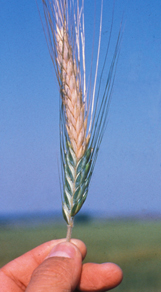|
|
Source: Barbara Valent, 785-532-2336, bvalent@k-state.edu
http://www.k-state.edu/media/mediaguide/bios/valentbio.html
Photo available. Contact media@k-state.edu or 785-532-6415.
News release prepared by: Erinn Barcomb-Peterson, 785-532-6415, ebarcomb@k-state.edu
Thursday, Jan. 15, 2009
K-STATE RESEARCHERS TO USE K-STATE'S BIOSECURITY RESEARCH INSTITUTE FOR $1 MILLION STUDY OF THE WHEAT BLAST FUNGUS THAT COULD THREATEN CROPS ACROSS THE STATE
MANHATTAN -- Kansas is lucky that a devastating wheat fungus isn't threatening the state's crops yet. Researchers at Kansas State University are getting $1 million from the U.S. Department of Agriculture to keep it that way.
 |
| A wheat head from a blast-infected wheat field in the state of Parana in Brazil. The upper spikelets, which appear straw-colored, have been damaged by the fungus. (Photo courtesy of K-State department of plant pathology) |
Barbara Valent, university distinguished professor of plant pathology, is leading a group of researchers to study the wheat blast fungus, a pathogen that has become a serious threat in Brazil.
"We don't know if our varieties in Kansas are susceptible, so we want to be prepared," Valent said.
The wheat blast fungus is a close relative of a devastating fungus that has long affected rice crops and another fungus that affects turf grass across the country. In the mid-1980s a close relative of these fungi began affecting wheat in and around Brazil, Valent said.
"It hasn't moved north from South America, but there's the potential that it could," she said. "We don't know where it came from or what effects climate change may have on it."
That's why the U.S. Department of Agriculture's Cooperative State Research, Education and Extension Service is providing $999,688 to study the fungus. The K-State researchers from the department of plant pathology include professors William Bockus and James Stack, and Xiaoyan Tang, associate professor. They will be working with Gary Peterson and Kerry Pedley of the U.S Department of Agriculture's Agricultural Research Service Foreign Disease-Weed Science Research Unit, Fort Detrick, Md., and with collaborators from Brazil's Embrapa Wheat group.
Fred Cholick, dean of K-State's College of Agriculture and director of K-State Research and Extension, said getting the $1 million grant recognizes K-State's experience in food safety and security in the field of plant health.
"This is what K-State as a land-grant university is all about -- solving problems before they have a global impact," Cholick said. "This is particularly important when you're talking about a wheat disease that could have a major impact on the economy."
Valent said the project comprises three areas, the first of which is sequencing the fungus's genome to find genome fragments specific to the wheat blast pathogen. Valent said this would help in the creation of diagnostic tools that field specialists can use in the field to identify wheat blast.
"The disease looks a lot like wheat scab, so it's important to train people to look for wheat blast and to discern between the two," Valent said. "The longer a disease goes unnoticed, the harder it is to control."
The second area of research is screening the Kansas wheat varieties for resistance to wheat blast. All work with the fungus will be done in K-State's Biosecurity Research Institute, a $54 million biosafety-level 3 facility in Pat Roberts Hall on the K-State campus.
"The Biosecurity Research Institute is a perfect facility for us to look at resistance in the Kansas varieties because we want to make sure the fungus doesn't spread," Valent said. "We're putting together a lab where the plants and fungus can be grown and stored, and where we can work with the fungus and destroy it after testing."
Beth Montelone, interim scientific director of the Biosecurity Research Institute, said, "We are very pleased that Dr. Valent and her colleagues will be bringing their wheat blast research to the BRI. We have a biosafety level 3-enhanced plant research laboratory that will offer excellent containment for this pathogen."
While K-State is doing research at the Biosecurity Research Institute, the U.S Department of Agriculture's Agricultural Research Service will be testing select wheat and barley varieties as well as potential grass hosts from other regions of the U.S. in the agency's biosafety-level 3 facility at Fort Detrick, Md.
Valent said that the genome sequencing part of the research will benefit from other campus resources as well, including a sophisticated genome sequencing apparatus that the Integrated Genomics Facility, housed in the department of plant pathology, recently acquired.
Valent said the researchers also will take advantage of the wheat varieties available at K-State's Wheat Genetic and Genomic Resource Center, led by Bikram Gill, university distinguished professor of plant pathology. The center maintains a gene bank with 2,500 wheat accessions.
Once the researchers have narrowed down a few Kansas varieties in the laboratory, they will further test the resistance by planting them in a test field in Brazil. "We'll let the fungus find our varieties naturally," Valent said.
The third aspect of the project involves sharing findings about wheat blast with stakeholders in the state's wheat production. This involves creating Web-based communication tools and organizing three workshops, individually tailored for extension professionals, industry professionals, policymakers or diagnosticians of the National Plant Diagnostic Network. Valent said that the workshops will take advantage of the Biosecurity Research Institute's capability to connect trainees in a conference room with scientists working in containment via video.
Valent said the project will offer experience to two graduate students, one in the communications field and another in plant science.
"One reason we're really excited about this project is that we're teaching students how to deal with plant bioterrorism threats," Valent said. "The student in the sciences will be taught not only how to look for resistance, but also how to do it in a high-containment environment. That's not something students often get a lot of experience in."